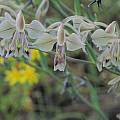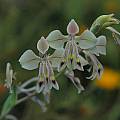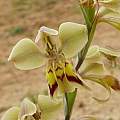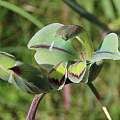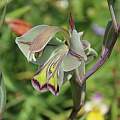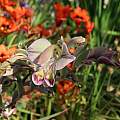There are about 163 species of Gladiolus (with new ones being discovered) in the area south of the Tropic of Capricorn and including Botswana, Lesotho, Namibia, South Africa, Swaziland, and Mozambique. Some are found in winter rainfall areas and some in summer rainfall areas. For more information see Goldblatt and Manning, 1998. Southern African species from Mi-Pa are pictured on this page.
Gladiolus index - Southern African gladiolus A-B - Southern African gladiolus Ca - Southern African gladiolus Ce-E - Southern African Gladiolus F-H - Southern African gladiolus I-Me - Southern African gladiolus Pe-R - Southern African gladiolus S-T - Southern African gladiolus U-Z - Gladiolus Hybrids - Miscellaneous gladiolus
Gladiolus microcarpus G.J.Lewis is endemic to the Drakensberg in KwaZulu-Natal, the Free State, South Africa and Lesotho. Plants grow on rocks and steep cliffs where their stems hang downward from vertical rock faces and their stems are anchored in crevices. During the growing season the habitat is moist. Flowers are bright pink with a broad white longitudinal zone in the lower two thirds of the lower three tepals and a narrow reddish purple streak in the midline. Height: up to 1 m. Photos taken by Cameron McMaster at Sentinel Peak, February 2008.
Gladiolus miniatus Eckl. is found on coastal limestone outcrops from Hermanus to Agulhas. Spring blooming flowers are salmon with red along the midline. Height: 15-40 cm. The first photo was taken by Dirk Wallace and the second and third by Cameron McMaster at Arniston. The last two photos were taken by Mary Sue Ittner in May 2005 when they were blooming for the first time from seed in Northern California with California bulb companions Brodiaea jolonensis, Allium unifolium and Triteleia hyacinthina in bloom in the same raised bed.
Gladiolus monticola Goldblatt & J.C.Manning is found on rocky sandstone slopes in the southwestern Cape. There are populations on Table Mountain. It has pink to apricot flowers with darker pink markings on the lower tepals and blooms summer into fall before the single leaf is produced. Height: 30-45 cm. The first two photos by Bob Rutemoeller. This first photo shows it as the only bulb blooming in one of our raised beds that only has bulbs from winter rainfall areas, blooming in July 2003 in the northern hemisphere. The leaf in the picture is of another Gladiolus that bloomed a month earlier. In the second photo we put cardboard behind the flowers to get the close-up that shows the details better. The third photo was taken years later by Mary Sue Ittner. The last photo from Rachel Saunders was taken on Table Mountain February 2011.
Gladiolus mortonius Herb. (formerly Gladiolus ochroleucus var. macowanii (Baker) Oberm.) is a summer rainfall Eastern Cape species that grows in open stony grassland. Although it resembles Gladiolus ochroleucus, it has a longer tube (30 to 45 mm versus 15-20 mm) and more strongly thickened midrib and leaf margins. The long-tubed pink flowers face to one side and have reddish streaks on the lower tepals. It is a gorgeous little gladiolus that grows successfully in a pot, producing flower stems around 8-9 inches (20-25 cm) tall, with comparatively large flowers that face slightly downwards. The photo (face) is taken upwards into the flower to show detail. The first three photos by Paul Tyerman show plants that have had a succession of flowers from late February (in Australia) and with a new spike in mid April just as the last of the previous flowers faded.
The photos below were taken in the Eastern Cape by Cameron McMaster February 2008. The first was taken at Andriesberg and the last two at Cathcart.
Gladiolus mostertiae is found in wet sandy soils in the Bokkeveld Mountains in the Northwest Cape. Growing 25 to 30 cm high, this species has linear leaves with a thickened midrib and pale pink flowers with yellow-green markings on the lower tepals. It flowers November to December. Photo taken by Rachel Saunders November 2013 near Nieuwoudtville in a year with late rainfall so the soil was still wet when it bloomed.
Gladiolus mutabilis (Harms) Goldblatt is an Eastern Cape species and also occurs in the eastern part of the Western Cape. Plants grow in sandstone derived soils. This species has slightly fleshy leaf blades without thickened margins or midribs and an elongated corm that is two to three times as long as wide. Flower color ranges from pale to dark blue, mauve, brown or cream. The lower tepals are usually cream or yellow below with dark blue or brown dots and streaks on the yellow background forming the nectar guide. The fragrant flowers appear early in the season, June or July. Height: 25-50 cm. The first photo was taken by Rachel Saunders who discovered this plant late July 2012 blooming in an area that had previously burned in the Western Cape. The next two photos were taken by Cameron McMaster August 2012 at the top of Potjiesberg Pass south of Uniondale (Eastern Cape) where it was growing with Gladiolus patersoniae. In the Western Cape population Gladiolus patersoniae was also in flower raising the question of whether they are both pollinated by the same pollinator. The last photo from the book Plants of the Klein Karoo courtesy of Jan and Anne Lise Schutte-Vlok.
Gladiolus natalensis see Gladiolus dalenii
Gladiolus nerineoides (N.E.Br.) G.J.Lewis is found on rocky sandstone slopes and cliffs in the southwestern Cape, flowering January-March. Growing from 35 to 60 cm high and flowering before the leaves are produced, it has funnel shaped scarlet flowers crowded together. Photos from iNaturalist taken by Peter Thompson in February and shared under a CC BY-NC license.
Gladiolus nigromontanus Goldblatt is a rare South African species that occurs only on rocky outcrops on sandstone slopes in the Swartberg Mountains. Flowering in autumn (March) and best a few years after a fire, it grows to 30-40 cm high with narrow leaves and small white long tubed flowers suffused light pink and marked with red and yellow on the three lower lobes. Flowers are in a 3 to 6 flower spike. Photos from the book Plants of the Klein Karoo courtesy of Jan and Anne Lise Schutte-Vlok.
Gladiolus ochroleucus Baker grows in grasslands and light bush or woodland in the Eastern Cape, occurring in areas with year round rainfall and in those areas is often evergreen. Flowers are either shades of pink, sometimes light purple or reddish, or whitish or yellow flushed brownish on the reverse. The dorsal tepal is hooded. The lower tepals are white in the lower half sometimes with dark red-purple median streaks. Height range: 40-80 cm. It flowers in summer and is pollinated by long tongued bees. Photos below were taken January 2008 by Cameron McMaster near Morgan Bay and the mouth of the Kei River in the Eastern Cape.
The photos below were taken near Morgan Bay by Bob Rutemoeller and Mary Sue Ittner.
Gladiolus odoratus see Gladiolus guthriei
Gladiolus oppositiflorus Herb. is found in the southern part of the summer rainfall area where it grows in open grasslands and often in rocky sites where there is some protection from predators. Flowers are salmon to pale pink or mauve, with the lower three tepals paler in the midline and having a reddish to purple median streak. Height range: 60-160 cm. This species blooms summer into fall. The first two photos by Mary Sue Ittner of a plant growing in the ground in Northern California and blooming late August-September 2004. The last two photos were taken by Cameron McMaster at Maclear in the Eastern Cape February 2008.
A shorter-stemmed form with salmon colored flowers was described as Gladiolus salmoneus Baker and later considered to be Gladiolus oppositiflorus ssp. salmoneus (Baker) Oberm. Although this subspecies is still recognized by Kew, Goldblatt and Manning in Gladiolus of Southern Africa did not think the differences warranted subspecies treatment. The first two photos of this form taken in the Eastern Cape January 2008 by Cameron McMaster. The last photo is from Rachel Saunders.
Gladiolus orchidiflorus Andrews is found on clay and sandstone soils from Namibia to Cape Flats and also to Free State and flowers in the spring. It has linear to sword-shaped leaves that are thickened in the midline. Flowers are in a 5 to 12 flowered spike, windowed in profile, greenish to purple with dark purple markings on the lower tepals, and are very fragrant. Plant height: 30-40 cm. Photos 1-2 are habitat shots taken in Namaqualand by Bob Rutemoeller and Mary Sue Ittner September 2006. Photos 3-4 were taken near Carolusberg, Namaqualand by Cameron McMaster September 2011.
The photos below were taken by Alan Horstmann.
Gladiolus ornatus Klatt is found on marshy sandstone and granite slopes in the Southwestern Cape, South Africa. Growing from 40 to 60 cm high, it has linear leaves and pink unscented flowers in a funnel shaped tube in a one to three flowered spike. The lower tepals each have a spear to spade shaped white median streak edged in dark pink and the lower part of the throat is white streaked with dark pink. Flowering is from September to November. Photo by Rachel Saunders.
Gladiolus overbergensis Goldblatt & M.P.de Vos is a rare species found in the southern part of the southwestern Cape. Growing from 35 to 50 cm high, it is reported to be found in sandy loam and fynbos or fynbos-renosterveld, flowering July-September. Flowers are bright red to orange with a long perianth tube which could make them adapted for pollination by sunbirds. Past names include Antholyza guthriei L.Bolus and Homoglossum guthriei (L.Bolus) L.Bolus. Photo from iNaturalist taken by Lindsay Lewis taken in the Overberg in June and shared under a CC BY-NC license.
Gladiolus paludosus Baker grows in Mpumalanga in marsh and vlei habitats that are wet much of the year. It has short-tubed pink or mauve, occasionally red unscented flowers; the lower lateral tepals have a broad diamond-shaped to semicircular band of dark mauve or purple across the midline. Height: 35-55 cm. Flowering time is mid October to mid November. It is very similar to Gladiolus crassifolius, but grows in a different habitat, flowers earlier, and has softer textured leaves and bracts. Photo taken by Rachel Saunders January 2015, much later than the usual flowering time.
Gladiolus papilio Hook.f. (syn. G. purpureo-auratus, G. brachyscyphus, G. spathulatus, G. schlechteri) is called the Butterfly Gladiolus, and grows in marshy ground, up to 2400 m, from the Eastern Cape to Limpopo Province. Height: 50-75 cm. It is claimed to be a hardy garden plant, grown in the UK since 1866. The first two photos were taken by Roy Herold in KwaZulu-Natal Province, near Kamberg in the foothills of the Drakensberg, in early December 2006. The third was taken by Rod Saunders. The fourth, an unusual color form, was taken by Rachel Saunders in the mountains above Tzaneen, early January 2015.
The photos below were taken by Cameron McMaster in Lesotho.
The first photo from John Grimshaw is of a form he labels in the "purpureoauratus" group. The second and third photos were taken by Bob Rutemoeller in the Mendocino Coast Botanical Gardens.
Gladiolus pappei Baker grows in marshes on sandstone slopes in the southwestern Cape. It flowers in spring. Height range: 20-35 cm. The first two photos show a plant that was grown from Silverhill seeds sown in September 2001 and first blooming in June 2003. Photos by Bob Rutemoeller and Mary Sue Ittner. The last photo was taken by Rachel Saunders.
Gladiolus pardalinus Goldblatt & J.C.Manning is restricted to the bushveld of Northern Province and Mpumalanga, South Africa where it grows in dolerite in rocky ground. Growing from 35 to 55 cm high, it has usually three leaves that sheath and envelope the stem and 10 to 15 flowers in a spike. Flowers are pale yellow speckled with red brown markings on all except the dorsal tepal. All of the tepals are clawed at the base. This species flowers in early spring, mid October and November. Photo from Rachel Saunders.
Gladiolus parvulus Schltr. is restricted to the southern half of KwaZulu-Natal, South Africa, into Lesotho where it grows in thin soil on sandstone pavements or in cracks in sandstone outcrops at elevations up to 3300 m. Growing from 15 to 35 cm, it has two leaves, the larger sheathing the stem and the second a small bract-like leaf immediately below the lowest flower. It has small horizontal to almost nodding light pink flowers with equal tepals. The flowers have been described as looking more like an Ixia or a Dierama. It flowers October to early December. Photo from Rachel Saunders.
Gladiolus patersoniae is widespread in the southern African winter rainfall areas. It occurs in exposed rocky habitats in the interior ranges of the Cape Floral region, but also near the coast at Cape Infanta and on stony alluvial flats near Worcester. It grows on soils derived from sandstone. Plants grow to 50 cm and have narrow cylindrical leaves. The bell like short tubed and sweetly scented (similar to apple and carnation) pale to deep blue, slate, grey or cream flowers are pollinated by long tongued bees. The lower three tepals have a transverse yellow band usually outlined in dark blue or purple. Flowering occurs in late winter to spring, earlier at lower elevations. The first five photos by Cameron McMaster. His last one was taken August 2012 at the top of Potjiesberg Pass south of Uniondale (Eastern Cape) where it was growing with Gladiolus mutabilis. The last photo from the book Plants of the Klein Karoo courtesy of Jan and Anne Lise Schutte-Vlok.
Gladiolus index - Southern African gladiolus A-B - Southern African gladiolus Ca - Southern African gladiolus Ce-E - Southern African Gladiolus F-H - Southern African gladiolus I-Me - Southern African gladiolus Pe-R - Southern African gladiolus S-T - Southern African gladiolus U-Z - Gladiolus Hybrids - Miscellaneous gladiolus













































